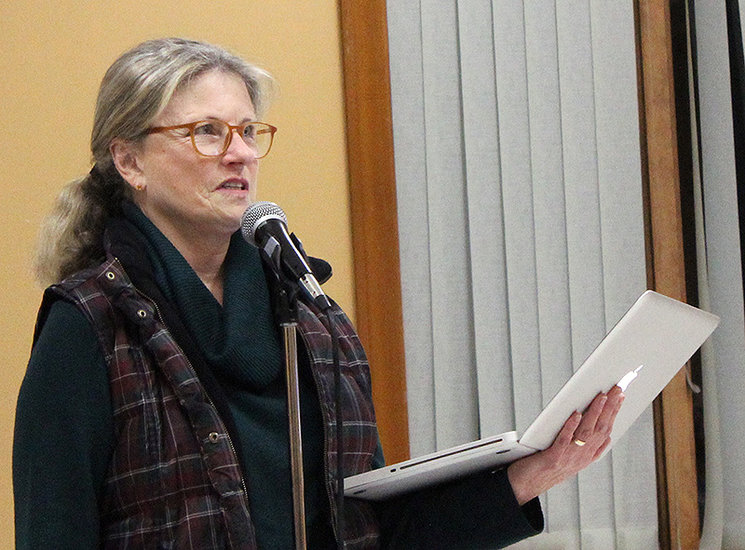Public hearing to remain open on proposed cell tower in Altamont
ALTAMONT — The planning board this week elected to keep open the public-comment period for the proposed 120-foot monopole telecommunications tower to be erected on village-owned property on Agawam Lane, saying that the 11 days the proposal was available for public view was not enough time for residents to weigh in on the project.
In 2013, the village board voted unanimously to sign a land-license agreement with Enterprise Consulting Services, of Slingerlands, “for the purpose of installing a communications tower,” according to the meeting minutes from 2013.
At the Dec. 17 planning board meeting, Dean Whalen, the village board’s liaison to the planning board, said that ECS had approached the village board in 2013 and, at the time, the board agreed only to allow ECS to market the land to potential tenants.
It’s taken all these years for ECS to sign up enough tenants to make the tower economically feasible. Josh Silver, the attorney for ECS, said that Verizon was the only tenant when the company presented its plan to the village board five years ago; now, AT&T and Hudson Valley Wireless have signed on as well. The tower is able to handle four tenants, Silver said.
Although the agreement was signed five years ago, the village does not receive any compensation from ECS until the tower is built. It is a five-year lease that ECS has right to extend for nine additional five-year terms. ECS has the right to not renew the agreement if it gives the village 90 days’ notice prior to the end of a five-year lease period. The village does not have the right to terminate the lease.
At the public hearing, resident Kristin Casey asked if the proposed tower needed a variance because the village code says there is a height limit of 100 feet.
Tim Wilford, the board’s chairman, told Casey that was not correct.
The tower’s height, Wilford said, “is not governed at all by the code.”
In fact, Wilford said, there is nothing about the proposed tower that conflicts with the village’s zoning code.
Later in the hearing, resident Harvey Vlahos asked how much the village would be receiving in rent from ECS. Wilford responded that he did not know how much the village would receive, and added that that was a village board issue and outside of the scope of the planning board’s job.
Silver was asked how much ECS was paying the village, and he responded by repeating Wilford’s point, that “the rent that the village would receive is not germane to the current conversation.”
In 2013, Bill Biscone, a representative of ECS, told The Enterprise that the village would receive about $7,000 per year per carrier.
Casey had also asked if other sites had been considered, a question asked again later in the hearing by Kirby Wilson.

Question: Altamont resident Kristin Casey at a public hearing on Monday peppered the village’s planning board with pointed questions about a proposed cell tower to be built on Agawam Lane.
Silver told Wilson that a number of different factors are examined when determining a site but it’s driven in large part by availability. He added that the company also looks for sites with some level of development on them already (the village-owned property on Agawam Lane has two water towers), as well as a site with some public-utility infrastructure.
“We found a village-owned parcel with village leadership that was interested in getting a tenant [like ECS],” Silver said.
Wilford went back to Wilson’s question: Had multiple sites been discussed?
Silver said that Agawam Lane site was what was offered up and fit the company’s needs at the time of the transaction.
Wilford, speaking to Wilson, answered her original question: “So, no, there was not many sites looked at; this was pretty much a joint effort, I believe, [Silver] is saying by them, the two parties.”
Casey, and later Vlahos, asked why they hadn’t been notified about the public hearing. ECS was required to send a notice about the public hearing to all residents who lived within 500 feet of the proposed project.
Casey said that she lives across the street from the proposed tower but surmised that she wasn’t within the required distance to be notified. She then said that the family next door to her is “literally steps away” from the site and knew nothing about the proposed project.
Vlahos told the board that he could stand at the end of his driveway and, if he had a decent arm, he could hit the proposed tower with a rock, but he did not receive any notice.
Vlahos was then given a list of addresses that had been sent a notice about the public hearing, which included 214 Main Street. Vlahos told the board if that house had received notice, then he should have as well as several of his neighbors.
Justin Heller, the planning board’s attorney, was asked by Vlahos, if proper notification had not been given, could the project move forward legally; would there be any ramifications if the people who were supposed to be notified by law were not notified?
Heller responded that it was a threshold question, whether the people entitled to a notification received it, adding that it was something the board can review.
“I can say with a high degree of confidence that I did not [receive notice] and several others did not either,” Vlahos said.
“I’m assuming that is a point of law; can you proceed on something where a public hearing is required and notification is not given?” Vlahos asked in a follow-up question.
Heller responded, “I guess what I am saying is, I’m not prepared to answer it right at this point.”
Nearly every resident who spoke expressed some kind concern with the visual impact that the tower might have.
One resident asked if the tower could go only as high as the treeline to mitigate its impact, but was told that the trees would block the tower’s signal, making it useless.
To determine the visual impact the proposed tower would have, ECS had a “balloon test” performed in September. For the test, a balloon was floated 120 feet into the air, then pictures were taken of the balloon from various points around the village, and then a cell-phone tower was photoshopped into the picture to give an accurate representation of what it would look like from those spots around the village. The photos are available at Village Hall.
Residents said they had not been notified that the balloon test would be taking place. When a tower was proposed for New Scotland, Casey said, both the public and local media were notified.
There was also the issue that the test took place in September, when the trees are full of leaves; residents asked that another test be performed now so that they can see what the tower would look like in winter.
The planning board was in agreement with the residents and also asked that another balloon test be performed. ECS agreed and said that it would be done before the next meeting, and that proper notices would be placed.
Wilford then said that the 500-foot requirement for notification was a minimum and asked that the radius be extended. Silver agreed with the chairman.
Wilford said that, like the general public, the planning board had only had access to the ECS application for 11 days prior to the meeting, and, even though there was nothing in the village code that prohibited the tower from being built, he agreed that 11 days was not enough time for the public to comment and decided to keep the public hearing open until the board’s Jan. 28 meeting.



